|
Opening Surveys
Marin: King’s Indian Torre Attack A48
1.d4 Nf6 2.Nf3 g6 3.Bg5 Bg7 4.Nbd2 0-0 5.c3 d6 6.e4 Nbd7
|
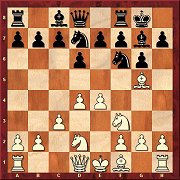
|
|
In
the second part of his series on the King’s Indian Torre
Attack Mihail Marin deals with the move 6...Nbd7,
preparing ...e5. But less pressure is exerted on d4, so
White can choose the moment to release the tension. Black
barely equalises.
|
Schipkov: Dutch A88
1.d4 f5 2.c4 Nf6 3.Nf3 g6 4.g3 Bg7 5.Bg2 0-0 6.0-0 d6 7.Nc3 c6 8.d5
|

|
|
Thanks to a few games by Nakamura the move 7...c6 has
been attracting some attention. Boris Schipkov too comes
to a positive conclusion after his investigations: in the
main variation, 8...e5 9.dxe6 Bxe6 followed by 10...Re8, Black can do well.
|
Schandorff: Caro-Kann B12
1.e4 c6 2.d4 d5 3.e5 Bf5 4.Nd2 e6 5.Nb3 Nd7 6.Nf3 a6
|
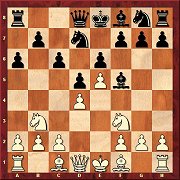
|
|
For a while Black had difficulties with the white setup with Nd2 and Nb3.
But with 6...a6 he prepares ...c5, without any possible
disruption from a bishop check on b5. After 7.Be2 c5 8.dxc5 it is important to recapture on c5 with the bishop.
|
Kritz: Sicilian B38
1.e4 c5 2.Nf3 Nc6 3.d4 cxd4 4.Nxd4 g6 5.c4 Bg7 6.Be3 Nf6 7.Nc3 0-0 8.Be2 b6 9.0-0 Bb7
|
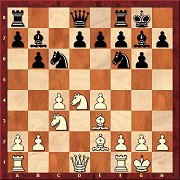
|
|
The
variation with 8...b6 is a speciality of Guseinov, and
previously also of his compatriot Gashimov. White has to
steer clear of various reefs, e.g. in the diagram 10.Qd2? Nxd4 11.Bxd4 e5! or 10.Rc1? Nxd4 11.Bxd4 Bh6!, but precise play promises him an advantage.
|
Breder: Sicilian B90
1.e4
c5 2.Nf3 d6 3.d4 cxd4 4.Nxd4 Nf6 5.Nc3 a6 6.Be3 e5 7.Nb3 Be6
8.f3 Be7 9.Qd2 0-0 10.0-0-0 Nbd7 11.g4 b5 12.g5 b4 13.Ne2
Ne8 14.f4 a5 15.f4 Bxb3
|

|
|
The
bishop move which leads to the diagram is an interesting
and as yet rarely played alternative to 15...a4, where
theoretical lines stretch far into the middlegame.
16.cxb3 a4 17.bxa4 Rxa4 18.Kb1 is followed by the rook sacrifice 18...Rxa2!
|
Kuzmin: French C11
1.e4 e6 2.d4 d5 3.Nc3 Nf6 4.e5 Nfd7 5.f4 c5 6.Nf3 Nc6 7.Be3 a6 8.Qd2 Qb6
|
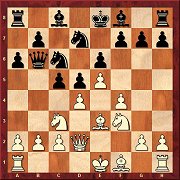
|
|
The move Qd8-b6
is not unusual in the French Steinitz, but in the move
order examined by Kuzmin it has rarely been seen. Some
things can be said in its favour, e.g. 9.Na4 Qb4! leads to a good ending.
|
Moskalenko: French C15
1.e4 e6 2.d4 d5 3.Nc3 Bb4 4.a3 Bxc3+ 5.bxc3 dxe4 6.Qg4 Nf6 7.Qxg7 Rg8 8.Qh6
|

|
|
The
move 4.a3 should not be under-estimated. The variation
leading to the diagram is almost forced. Then Black has a
greater choice of moves. Botvinnik always played 8...c5,
but Shirov sees a strong white bishop pair and
recommends 8...Rg6. Moskalenko likes a setup with ...Nbd7 and ...b6.
|
Anic: Two Knights Defence C55
1.e4 e5 2.Nf3 Nc6 3.Bc4 Nf6 4.d3 Be7 5.0-0 0-0
|
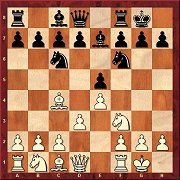
|
|
In this quiet variation of the Two Knights Defence White’s intentions are relatively clear: c3, Bb3, Re1, Nbd2 and a4. Darko Anic recommends for Black a setup with d6 and Nfd7. The ideas behind it: ...Bf6, ...Nc5, later possibly even d6-d5 too.
|
Breutigam: Ruy Lopez C96
1.e4 e5 2.Nf3 Nc6 3.Bb5 a6 4.Ba4 Nf6 5.0-0 Be7 6.Re1 b5 7.Bb3 d6 8.h3 0-0 9.c3 Na5 10.Bc2 c5 11.d4 Nd7 12.Nbd2 exd4 13.cxd4 Nc6
|

|
|
This variation, which leads after14.d5 Nce5
to a Benoni structure, bears the name of the German
grandmaster Alexander Graf. Some lines are really sharp,
something which many players of the white pieces are not
really intending.
|
Postny: Queen’s Gambit Accepted D20
1.d4 d5 2.c4 dxc4 3.e4 e5 4.Nf3 Bb4+ 5.Nc3 exd4 6.Nxd4
|
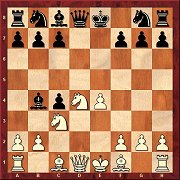
|
|
The move 5.Nc3
has been really popular recently. But the results of the
analysis by Evgeny Postny are very satisfactory for
Black; for example, he considers 6...Nd7!? to be playable for Black. Perhaps White must turn back to 5.Bd2 after all.
|
Krasenkow: Semi-Slav D31
1.d4 d5 2.c4 e6 3.Nc3 c6 4.Nf3 dxc4 5.e3 b5 6.a4 Bb4 7.Bd2 a5 8.axb5 Bxc3 9.Bxc3 cxb5 10.b3 Bb7
|
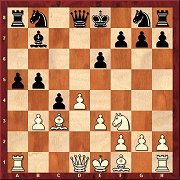
|
|
First of all, the author shows that in the Noteboom
Variation Black need not fear the move 11.d5. Thereupon
he examines the sub-variations which are possible after
the main continuation 11.bxc4 b4 12.Bb2 Nf6 13.Bd3 Nbd7 14.0-0 0-0.
|
Stohl: Queen’s Gambit D38
1.d4 d5 2.c4 e6 3.Nc3 Nf6 4.Nf3 Bb4 5.cxd5 exd5 6.Bg5 Nbd7 7.e3 c5 8.dxc5
|
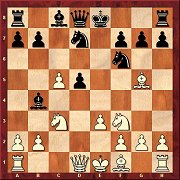
|
|
So
far, the exchange 8.dxc5 has only been a side variation,
but after the developments of recent months and above
all the very recent game Jakovenko-Fressinet, Plovdiv
2012, for the first time Black is obliged to start
looking for improvements.
|
Grivas: Semi-Slav D44
1.d4 d5 2.c4 e6 3.Nc3 c6 4.Nf3 Nf6 5.Bg5 dxc4 6.a4
|
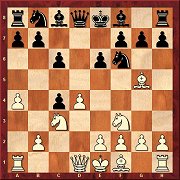
|
|
6.a4 allows White to avoid the long lines of the
Botvinnik Variation (6.e4). But does he also manage
something of an advantage? On the positive side for White
is the fact that there is no clear-cut equalising
continuation for Black, and in some lines he really gets a
small advantage.
|
|